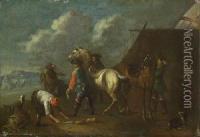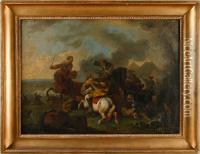Tobias I Querfurt Paintings
Tobias Querfurt, also known as Tobias I Querfurt to distinguish him from his nephew of the same name, was a German artist and painter born in the year 1660. He is recognized for his contributions to Baroque art, particularly in the genre of landscape and animal painting. Tobias was born in the town of Querfurt, which is in present-day Saxony-Anhalt, Germany, and hence the surname that references his place of origin.
Querfurt's artistic training and early career remain somewhat obscure, but it is known that he was active during a period that saw the flourishing of Baroque art across Europe. His works were influenced by the dramatic style of the time, with a strong emphasis on contrast, movement, and vivid detail. Tobias Querfurt is noted for his ability to depict animals with remarkable realism and vitality, which made him a sought-after artist for commissions involving hunting scenes and naturalistic landscapes.
His life was spent traveling and working in various courts and cities in Germany and beyond, which was common for artists of his era who often sought patronage from nobility and the wealthy. Though not as widely recognized as some of his contemporaries, Querfurt's work did gain him a modest level of fame during his lifetime. He was known to have worked in Wroclaw (then Breslau) and Berlin, among other places, which suggests that he was part of the broader artistic circles in those regions.
Tobias Querfurt's death occurred in 1734, after which he was survived by his nephew and namesake, Tobias Querfurt II, who was also a painter and whose works are sometimes confused with those of his uncle. Tobias I Querfurt's legacy is preserved through the paintings that remain, many of which are held in European art collections, demonstrating his skill in capturing the spirit of the Baroque era through his detailed and dynamic compositions of nature and wildlife.

